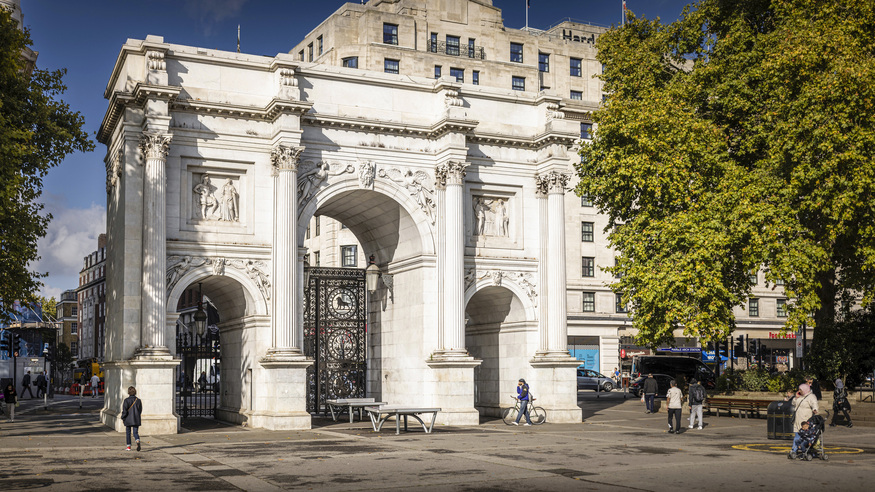
Marble Arch: the end of Oxford Street you only venture to if the other two branches of Clarks don't have your size. The name, of course, comes from John Nash's hunk of Romanesque pomp, shifted from Buckingham Palace to the top right hand corner of Hyde Park in 1851. Thomas Cubitt added rooms, one of which was used by the Met Police but wasn't actually a police station.
Before the relocation of the arch, the area was best known as Tyburn*, or Tyburnia, after the river that ran through it.
Of course, the fearsome 'hanging tree' that loomed around here from as early as 1108 was what really gave the area its fame (or rather, infamy). Long after the gallows were dismantled in 1783, the name still echoed around, as in this 1827 map, marking the Tyburn Turnpike:

A passage from the 1878 edition of Old and New London: Volume 5 confirms the name Tyburnia lived on over 25 years after the Marble Arch was installed:
Tyburnia... of late years has become almost, if not quite, as fashionable and aristocratic as Belgravia
The area's modern name was probably only cemented after the introduction of Marble Arch tube station in 1900.
Greenwood's map raises another possible pre-Marble Arch name: Cumberland Gate. This Illustrated London News print, from the year in which the Marble Arch was moved, references Cumberland Gate — still there today:

In fact, the Marble Arch and its namesake station are surrounded by Cumberland Gate, Great Cumberland Street, Great Cumberland Place and The Cumberland Hotel. Cumberland Gate Lodge is here too; the erstwhile posh WC was shifted a bit to the west to make way for, you guessed, the Marble Arch. Next time you go for a picnic in Hyde Park, insist on meeting at 'Cumberland' and see if your friend ends up here or 300-odd miles north.
*There's still a patch of Birmingham called Tyburn, which takes its name from London's Tyburn
Crystal Palace

As Marble Arch was shifted to Hyde Park in 1851, the Crystal Palace was being shifted from it.
In 1854, Sydenham Hill became the new home for Joseph Paxton's glass-terpiece, which had housed the Great Exhibition three years previous. The Crystal Palace only officially took on the name Crystal Palace at its new home — the moniker was originally a nickname coined by the satirical publication Punch.
A station, named Crystal Palace (Low Level), was opened to service south London's sparkling new attraction; Sydenham Hill quickly fell out of use (though never entirely — it still exists now). Crystal Palace FC aka 'the Glaziers' were founded in 1905, adding more sparkly association to the area.

Even faster than it was re-erected, so the palace disappeared — in a puff of smoke on 30 November 1936. The name didn't go anywhere though, and from time to time Crystal Palace still surely disappoints visitors with its lack of an actual crystal palace. Just as a visit to Crystal Palace FC often disappoints with its lack of football team.
Barbican

The wind had died down and a million fragments of ash and embers snowed down on them. The tarmac in the road was still burning in places. A few walls, strengthened by their chimneys, stood like headstones. The remaining buildings were ghosts...
According to one observer, this is how Cripplegate — an ancient quarter of the City of London — was effectively wiped out overnight, thanks to a heavy bombing raid on 29 December 1940. The striking name, suggests Tom Bolton in his book Vanished City, may have derived from a legend that says Saint Edmund of East Anglia once cured cripples as they passed through the gate here.
As we mooted in a video on the gates of the City, 'Cripplegate' may also derive from the Anglo-Saxon word 'crepel', which means subterranean passageway.
The Barbican Estate began to rise slowly from the rubble in the late 1950s — named after the Roman fort that stood here centuries ago, part of which became the Cripplegate itself.

You'll still see signs for Cripplegate now; it still exists as one of the City's wards (divided into 'within' and 'without'). Barbican's incongruous St Giles Church — parts of which date back to 1394 — is dedicated to the patron saint of cripples.




